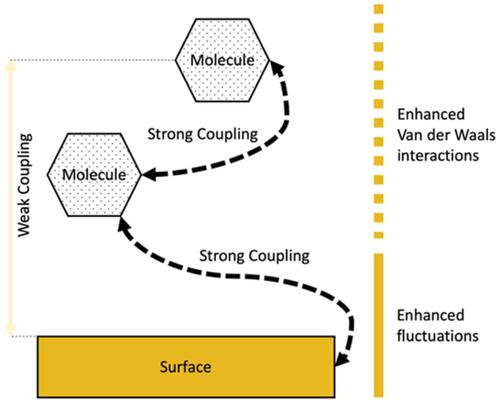当前位置:
X-MOL 学术
›
Int. J. Quantum Chem.
›
论文详情
Our official English website, www.x-mol.net, welcomes your
feedback! (Note: you will need to create a separate account there.)
Many‐body response of benzene at monolayer MoS2: Van der Waals interactions and spectral broadening
International Journal of Quantum Chemistry ( IF 2.3 ) Pub Date : 2020-04-11 , DOI: 10.1002/qua.26243 Alina Umerbekova 1, 2 , Michele Pavanello 1, 2
International Journal of Quantum Chemistry ( IF 2.3 ) Pub Date : 2020-04-11 , DOI: 10.1002/qua.26243 Alina Umerbekova 1, 2 , Michele Pavanello 1, 2
Affiliation

|
Models of surface enhancement of molecular electronic response properties are challenging for two reasons: (a) molecule‐surface interactions require a simultaneous solution of the molecular and the surface dynamic response (a daunting task), and (b) when solving for the electronic structure of the combined molecule + surface system, it is not trivial to single out the particular physical effects responsible for enhancement. To tackle this problem, in this work, we apply a formally exact decomposition of the system's response function into subsystem contributions by using subsystem density functional theory (DFT), which grants access to dynamic polarizabilities and optical spectra. In order to access information about the interactions between the subsystems, we extend a previously developed subsystem‐based adiabatic connection fluctuation‐dissipation theorem of DFT to separate the additive from the nonadditive correlation energy and identify the nonadditive correlation as the van der Waals interactions. As an example, we choose benzene adsorbed on monolayer MoS2. We isolate the contributions to benzene's dynamic response arising from the interaction with the surface, and for the first time, we evaluate the enhancements to the effectiveness of C6 coefficients as a function of benzene‐MoS2 distance and adsorption site. We also quantify the spectral broadening of the benzene's electronic excited states due to their interaction with the surface. We find that the broadening has a similar decay law with the molecule‐surface distance as the leading van der Waals interactions (ie,
R−6) and that the surface enhancement of dispersion interactions between benzene molecules is less than 5% but is still large enough (0.5 kcal/mol) to likely play a role in the prediction of interface morphologies.
中文翻译:

苯在单层MoS2上的多体响应:范德华相互作用和光谱展宽
分子电子响应特性的表面增强模型具有挑战性,原因有二:(a)分子-表面相互作用需要同时解决分子和表面动态响应(一项艰巨的任务),以及(b)解决电子结构时对于组合的分子+表面系统而言,选择负责增强作用的特定物理效应并非无关紧要。为了解决这个问题,在这项工作中,我们使用子系统密度泛函理论(DFT)将系统响应函数的形式精确分解应用到子系统贡献中,该理论允许访问动态极化率和光谱。为了访问有关子系统之间交互的信息,我们扩展了以前开发的基于DFT的基于子系统的绝热连接波动耗散定理,以将添加剂与非添加剂相关能分开,并将非添加剂相关性识别为范德华相互作用。例如,我们选择吸附在单层MoS上的苯2。我们分离了与表面相互作用对苯的动态响应的贡献,并且首次评估了C 6系数的有效性随苯-MoS 2距离和吸附位点的变化。我们还量化了由于苯与表面的相互作用而引起的电子激发态的光谱展宽。我们发现,与领先的范德华相互作用(即,R -6 ),并且苯分子之间的分散相互作用的表面增强作用小于5%,但仍足够大(0.5 kcal / mol),可能在界面形态的预测中发挥作用。
更新日期:2020-04-11
中文翻译:

苯在单层MoS2上的多体响应:范德华相互作用和光谱展宽
分子电子响应特性的表面增强模型具有挑战性,原因有二:(a)分子-表面相互作用需要同时解决分子和表面动态响应(一项艰巨的任务),以及(b)解决电子结构时对于组合的分子+表面系统而言,选择负责增强作用的特定物理效应并非无关紧要。为了解决这个问题,在这项工作中,我们使用子系统密度泛函理论(DFT)将系统响应函数的形式精确分解应用到子系统贡献中,该理论允许访问动态极化率和光谱。为了访问有关子系统之间交互的信息,我们扩展了以前开发的基于DFT的基于子系统的绝热连接波动耗散定理,以将添加剂与非添加剂相关能分开,并将非添加剂相关性识别为范德华相互作用。例如,我们选择吸附在单层MoS上的苯2。我们分离了与表面相互作用对苯的动态响应的贡献,并且首次评估了C 6系数的有效性随苯-MoS 2距离和吸附位点的变化。我们还量化了由于苯与表面的相互作用而引起的电子激发态的光谱展宽。我们发现,与领先的范德华相互作用(即,R -6 ),并且苯分子之间的分散相互作用的表面增强作用小于5%,但仍足够大(0.5 kcal / mol),可能在界面形态的预测中发挥作用。











































 京公网安备 11010802027423号
京公网安备 11010802027423号